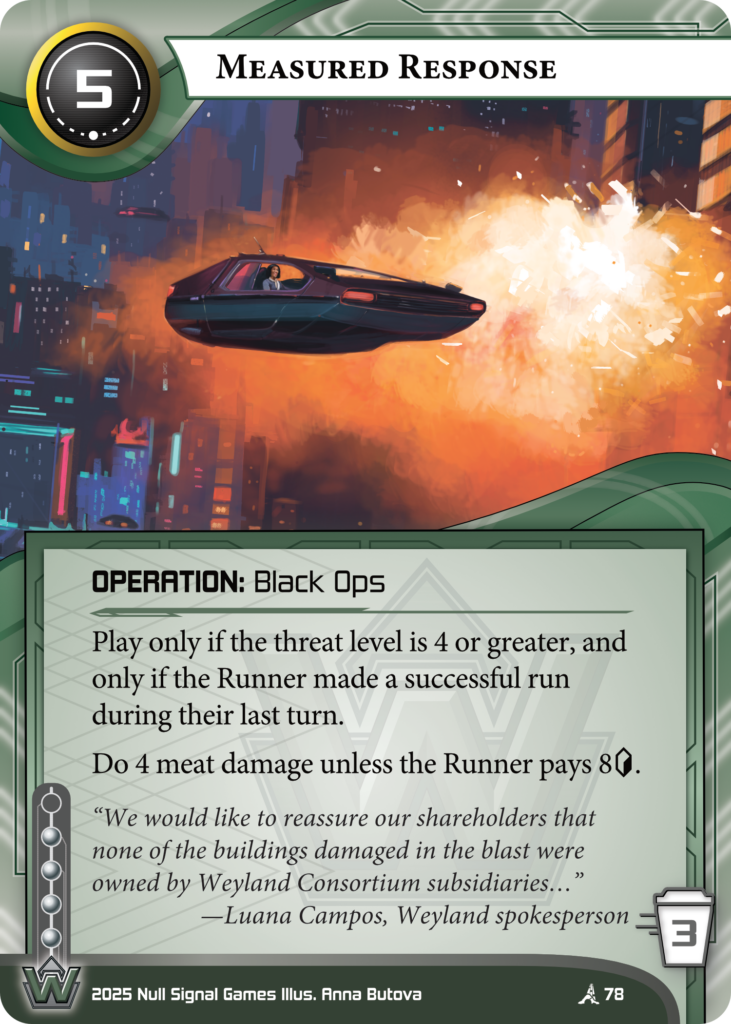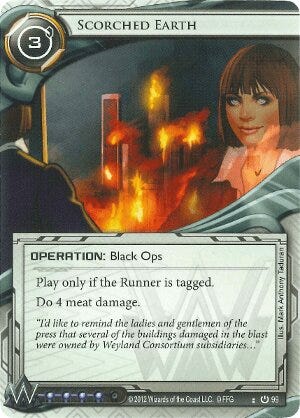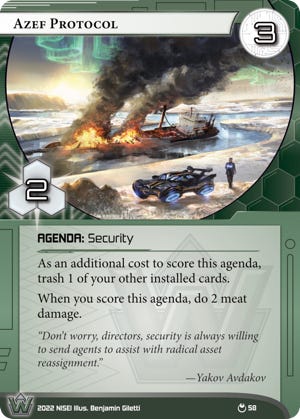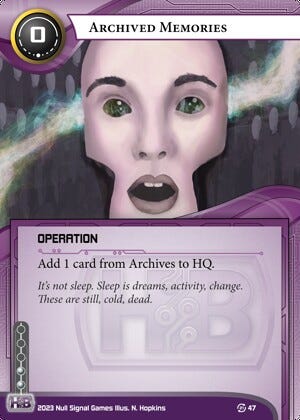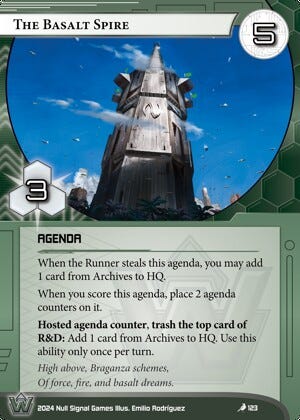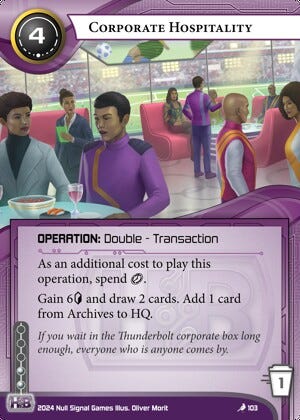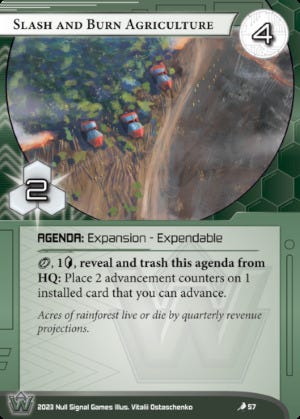Previewed here: https://nullsignal.games/blog/measured-response-a-tale-from-elevation-development/
Another day, another Weyland card out to flatline careless runners. This card exists not just to end the game, but to change the dynamic throughout the game and force the runner to be more cautious in their approach.
I’d like to take some time to talk about that dynamic when compared with the dynamic of Punitive Counterstrike, the card this is replacing. I’ve seen a lot of people call this “weaker” Punitive Counterstrike, which is an opinion I don’t share. I think the power of this card manifests in different ways, and while it is less likely to flatline runners, it is much more likely to have major impact over the course of a game.
As an aside, while the flavor text is a lovely homage to Scorched Earth, because Measured Response doesn’t interact with tags at all, it is mechanically very distinct. The card End of the Line from Parhelion is the successor to Scorched Earth in that respect, filling the role of “Tag-and-Bag” win condition.
Punitive Counterstrike has been around for most of the game’s life now, and has not seen great competitive success. It is also a classic case of the card text not really telling you what the card does. Here’s what Punitive Counterstrike actually does in most games it is played:
Your deck must primarily or exclusively consist of 5/3 agendas.
In order to play this card, you must have another copy of this card in HQ (or otherwise available) and another click to play it with.
The Runner needs to have stolen a 3-point agenda on their last turn.
In order to play this card, you must have approximately twice as much money as the Runner.
The Runner does not have ways to increase their hand size, prevent the damage, or boost the number of cards in their hand.
If all of these conditions are met, the card simply reads “you win the game”.
Your deck must primarily or exclusively consist of 5/3 agendas
Starting at the top, Punitive Counterstrike requires you to build your deck, or at least your agenda suite, around it. Part of the reason why Punitive Counterstrike is quite good right now is because of the existence of 5/3 agendas that enable it in Jinteki. Bacterial Programming and Fujii Asset Retrieval fit in very well with the Punitive Counterstrike game plan.
By contrast, Measured Response doesn’t enforce a specific kind of agenda suite. There are certainly agendas that work better with Measured Response like Azef Protocol, but the card will still function regardless of your specific agendas. All it cares about is that you reach Threat 4.
You must be able to play two copies of Punitive Counterstrike in the same turn
You don’t necessarily need to have drawn two copies. though the Standard ban of Archived Memories was another big hit to the viability of this strategy. A single copy of Punitive Counterstrike is unlikely to flatline the Runner and as such is not worth the money and click to play. The existence of Bacterial Programming is one reason why the card is having a resurgence in Standard, as it can both draw copies of Punitive as well as set up this situation with some level of reliability on the Corporation’s side.
Punitive Counterstrike decks tend require a lot of setup, leaving them vulnerable in the early game. If a Runner is able to score three points before the Corporation has drawn into their copies of Punitive Counterstrike, it puts them in a much better spot going into the midgame.
Measured Response is a little more likely to flatline with a single copy, dealing four meat damage, but ultimately still unlikely. As such, the Corporation will still have to dig through R&D to find multiple copies if they want any chance of winning the game using Measured Response.
However, there is one massive difference here that sets the two cards apart; the Corporation doesn’t need to have the two copies in hand when the Runner steals the agenda. This is because…
The Runner needs to have stolen a 3-point agenda on their last turn
Punitive Counterstrike’s text tends to be entirely blank except for one, possibly two turns across an entire game. This is the biggest difference with Measured Response and I think one that is at the root of people’s assumption it is “weaker Punitive”.
Measured Response only requires that the Runner made a successful run on their last turn. They don’t need to have stolen any agendas or trashed any cards, merely that the run was successful. As soon as Threat 4* is active, every turn of the game, if the Runner makes at least one successful run, they must be aware of the danger of retaliation.
* If a runner steals an agenda and reaches Threat 4 as a result, they’re also immediately in the crosshairs. As such, you could argue this card is active from Threat 2, assuming your deck is all 2-point agendas.
Punitive Counterstrike is also much easier to disrupt because of this single-turn window. Runner cards like the Class Act can allow them go above hand size for a single turn, denying the Corporation any chance of a flatline. But even without such specific cards, if the Runner suspects a Punitive Counterstrike, they’ll make sure to stock up their grip on any turn they stole an agenda.
Measured Response doesn’t have the limitation of a single-turn window in the same way. Again, as soon as the Threat 4 is reached, any time the Runner makes a successful run, they must be aware of the consequences. As a result, the Runner must keep an eye on the number of cards in their grip and their credits any time they make a run. This threat of the card being played, rather than the card actually being played, is maybe Measured Response’s bigger strength; a Runner must slow down and respect the danger, giving the Corporation some breathing room.
In order to play this card, you must have approximately twice as much money as the Runner
This is the spot where Measured Response is undeniably easier for the Runner to play around; as long as they have at least eight credits, they can negate the damage. However, eight credits is far from trivial, and as mentioned above, it is a risk that the runner must respect any time they make a successful run. Because Punitive Counterstrike uses a Trace, the amount of credits required is much more dynamic.
In both cases, however, the strategy is similar; force the Runner to choose between expending their credits to steal an agenda, which risks a retribution, or to let you score out agendas without contesting them.
The Runner does not have ways to prevent a flatline
This got touched on before when talking about the single-turn window, but is worth expanding on: if the Runner can prevent a flatline, Punitive Counterstrike often becomes a useless card.
As soon as the Runner is able to live through a the Punitive turn, the other copies of the card tend to be useless, and the threat of the flatline is diminished or outright gone. Even if the Corporation has the means to recur the Punitive Counterstrike, the opportunity to play it may no longer apply. This is especially true for decks that round out their agenda suites with 1-point agendas. If the runner manages to get to four points, then next time they steal a 3-point agenda they’ll win the game before the Corporation can retaliate.
Measured Response doesn’t have this restriction at all. If you are able to recur it, you can keep reuse it, compounding the economic pressure and danger. Even if the Runner is aware of it, they must still respect the threat, which means clicks spend drawing cards and stockpiling credits rather than running as aggressively as they would otherwise be want to do.
If all of these conditions are met, the card simply reads “you win the game”.
This is where we get to the crux of the evaluation; most Punitive Counterstrike decks must win through Punitive Counterstrike. Their backup plan of actually scoring the agendas tends to be so much worse. If the Runner is able to navigate the threat of the Punitive turn, their chances of winning go up astronomically.
The current Standard decks get around this somewhat by using Regenesis. But outside of Jinteki, the success of this strategy is currently hard to replicate.
I suspect most Measured Response decks will go entire tournaments without ever flatlining a runner. And so people evaluating Measured Response by its ability to flatline are entirely correct; it is much worse than Punitive Counterstrike. However, that is missing one absolutely vital detail: Measured Response can go into decks that have a regular scoring plan. And without the restriction on the agenda suite, that opens up a whole range of decks that could potentially employ this.
Going back to the top with Scorched Earth, we find it was used in a strategy called “Supermodernism” which was able to use SEA Source to tag the Runner, then play two copies of Scorched Earth to flatline. But while this is flashy, it is important to realize that this strategy could be entirely avoided by the Runner simply having more money than the Corp. As long as the Runner could pay off the Trace from SEA Source, they couldn’t be touched.
And that was the plan. Because Supermodernism was a deck that planned to go fast and score its agendas, relying on the threat of this flatline to delay the Runner. Even if the Runner could break all of the ICE, could they break the ICE and still have enough credits left over to avoid the dreaded Sea Source - Double Scorch?
And so, we come full circle. While Measured Response is by no means as reliable or powerful as Scorched Earth, I suspect it will result in a similar kind of Supermodernism play pattern. One where the question isn’t if the Runner can get in, but whether they can survive the Corporations… Measured Response.
The upcoming set Elevation marks a new era for Netrunner. With new cards for all major factions, Elevation sits alongside System Gateway to define the core experience of Netrunner for years to come.




